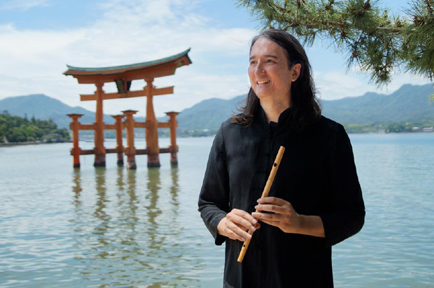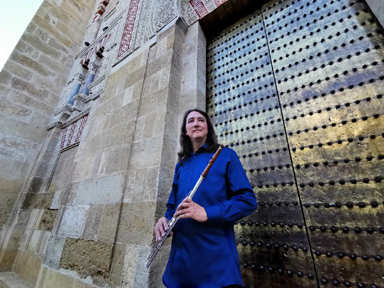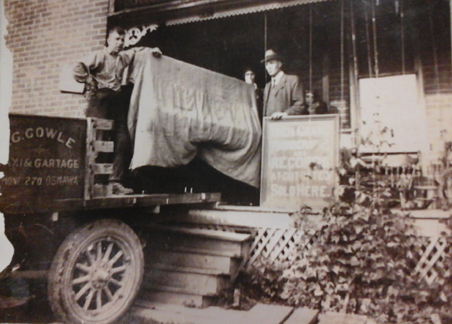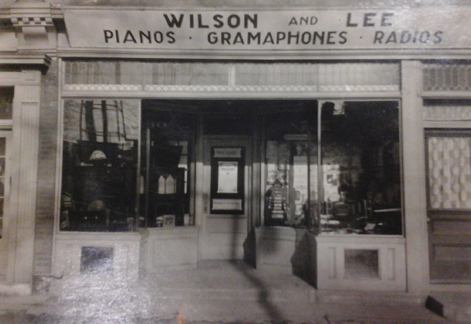Durham’s Grammy Nominee: Flautist and Composer Ron Korb
© By John Arkelian
In the world of music, being nominated for a Grammy Award is the

Ron Korb at Itsukishima Shrine in Japan — © 2020 by Ron Korb.
equivalent of an Oscar nomination. “It’s just something people respect,” says composer and flautist extraordinaire Ron Korb. His solo album “Asia Beauty” was nominated for a Grammy in late 2015 and Korb had the pleasure of attending the ceremony at Los Angeles’ Staples Center a few months later. But that album’s recognition doesn’t tell the whole story: Korb has more than 20 albums under his belt, with musical styles that run the gamut: Irish, Celtic, Latin, and Asian influences are on rich display in the music he composes himself. It’s rare for flautists to compose their own music; but Korb has been composing from the get-go, with impressive results. That versatility was on full display at a May 2017 concert in Ajax, Ontario, in which we encountered echoes of Bach, a recreation

Ron Korb in Bali — © 2020 by Ron Korb.
of an Irish jig, and colorful influences from the Orient. One fanciful piece, “Mozart’s Wedding,” was a contemporary reimagining of music in the style of Mozart – as irresistibly lively as it was lovely, it was a show-stopper. The man’s evocative music casts a spell.
Sprightly, full of zest, and emotive, Korb’s music is inextricably connected to storytelling. His ‘concept albums’ usually combine a story with the music, with themes that range from the mythological to the intimate. That love of storytelling is integral to Korb’s work: “It has to do with the way I communicate with myself,” he says. Maybe it’s an echo of his early aspirations of becoming a filmmaker? Fittingly enough, Korb has worked in film and television – as a musician. You’ll hear him on the score of 2004’s “Being Julia” and 1999’s underrated “Ride With the Devil,” as well as the IMAX

Ron Korb in Cordoba, Spain — © 2020 by Ron Korb.
documentary films “Space Station” (2002) and “A Beautiful Planet” (2016), to cite just a few examples. In 2019, Korb was the first thing we heard on the first episode of a classy television series called “The Terror: Infamy,” which, serendipitously, happened to concern Japanese-Americans who were unjustly interned during the Second World War. ‘Serendipitous’ because Korb’s maternal grandmother was Japanese. Hailing from a high society family in Japan, she adapted to that era’s rough-and-tumble frontier life in Prince Rupert, B.C. She was also a pretty fair artist; so, Korb’s artistic bent may have been bred in the bone.
Creativity was certainly not lacking in Korb’s childhood home. His father was a gifted inventor with a discerning ear. Relocating from Toronto to Ajax when he was 11, Korb finished his primary and secondary education in Durham. His first hands-on exposure to an instrument was in school, with a recorder. The flute soon followed. He caught the musical bug early. There was something about the flute, something that first caught his eye (and ear) as a child when he happened to see Canadian flute great Moe Koffman interviewed on television’s “Take 30.” Koffman, who both improvised and wrote music, was to be an archetype for Korb. In high school, Korb started his own band, though he’s still bemused that even then he played the flute, rather than the more standard guitar. He spent a formative year at York University, immersing himself in jazz and world music, dabbling in student plays and student films, and making musical friends who remain collaborators today. Then, it was off to the Faculty of Music at the University of Toronto, where the emphasis was exclusively on classical music and its preoccupation with ‘tone,’ as opposed to the pride of place accorded by jazz music to ‘rhythm.’ Hewing to the Chinese maxim “bitter first, sweet later,” Korb saw the sense in mastering the fundamentals before charting his own musical course. Most of what he performs is his own music. The work can be solitary, but Korb says there is something indescribably joyful about getting together with like-minded people on a concert stage or in a recording studio.
Korb has played with full orchestras in his movie work, worked with performers like Olivia Newton John, and collaborated with artists from near and far who have mastered instruments like the ancient Chinese stringed instrument called the ‘erhu,’ in the years since his album debut with 1989’s “Tear of the Sun.” He has toured Asia many times, where music aficionados in places as diverse as Taiwan, China, and Japan have bestowed affectionate honorary monikers on him, like ‘Dragon Flute.’ Korb often organizes his own multi-country tours, a logistical feat that he has mastered as ably as his music. Other tours have taken him around the world. And his new album, “World Café,” is an immersion in the musical sounds of Spain and Latin America.
Korb’s creativity and his artistry as a performer are complemented by his thoughtfulness – and by an admirable sense of perspective. Certainly, he’s proud that he has been able to continue to make his own music and be independent. But deeper values loom larger still. He has an able partner in his wife Jade, who is a talented photographer and adeptly handles the graphic design on his albums. And, when asked about his proudest accomplishment, Korb cites being there for his parents during their terminal illnesses: “I didn’t let them down. My wife and I were both there for them.” There’s that sense of perspective again. His hope for 2020 is that it will be a year of reflection, and he has already begun that process, reflecting upon what in life really matters and what (for any of us) really endures. Korb says that ‘There’s a special joy that comes when someone really gets my music.’ And, making us envious about his success in finding his destined niche in life, he adds: “Playing music is pretty much one of the most fun things you can do.”
John Arkelian is an award-winning author and journalist.
Copyright © 2020 by John Arkelian.
The foregoing profile also appeared in the Spring 2020 edition of Grapevine Magazine.
Note: Visit Ron Korb at: https://www.ronkorb.com/
*************************************************
Late Great Composers for Film & Television
© By John Arkelian
We lost two masterful composers in 2020, creative artists whose music inimitably embodied the very essence of the films and television series for which they composed their unforgettable scores.
Ennio Morricone (1928-2020) scored over 500 films for the big screen and television, among them, “The Mission” (1986), “The Untouchables” (1987), and “The Hateful Eight” (2015). He won the Oscar for Best Original Score for the latter film. But, for many of us, he’ll be best remembered for his collaborations with director Sergio Leone and their so-called “spaghetti westerns,” like “The Good, the Bad, and the Ugly” (1966). A key track from that score, “The Ecstasy of Gold,” was used to award-caliber effect in a wonderful 2012 Olympics commercial for the Canadian hardware chain RONA. It’s a note-perfect marriage of memorable music and sweeping vistas with energetic momentum, and Artsforum named it the best television commercial of the year. Artful, moving, inspiring, and at moments wry, it’s our idea of a truly national anthem for Canada. It’s a compelling minute or so of music paired with images – and how often can one say that about a commercial? Here’s a link to a slightly shortened version of the original commercial:
https://www.youtube.com/watch?v=QjSwWgtKZRQ
Robert (Bob) Cobert (1924-2020) made an indelible impression with his wonderfully evocative score for the Gothic drama “Dark Shadows” (in its original 1966-71 version, its 1970 & 1971 big-screen adaptations, and its lush 1991 prime-time remake). By turns haunting, suspenseful, mysterious, melancholy, and classically romantic, his sometimes gentle, sometimes ferocious, score became a bestselling soundtrack album, as it gave musical voice to a centuries-spanning tale of tragic romance and supernatural suspense. Cobert’s collaboration with producer/director Dan Curtis continued with two mammoth television mini-series, “The Winds of War” (1983) and “War and Remembrance” (1988), earning Cobert a Primetime Emmy nomination for Best Score. But, here’s a sampler from his grippingly emotive music from “Dark Shadows:”
https://www.youtube.com/watch?v=WXPytvEcg1w&list=PLD9A2F99FDCB0B033&index=4
Copyright © 2020 by John Arkelian.
*************************************************
The Music Mavens
© By John Arkelian
A 97-year old family business will shutter its doors by year’s end,

David & Bill Wilson – photo © 2019 by John Arkelian.
and both the city where it is situated and its far-flung customers will be the poorer for it. Wilson & Lee Music Store has been a constant presence in downtown Oshawa, Ontario since 1922, when a blind piano tuner from Toronto named William George Wilson and his sister-in-law Mary Lee opened it as a place to buy pianos, radios, gramophones, violins, and music-rolls for player pianos. The business is now run by Bill and David Wilson, the grandsons of the founder: Bill has been at the store for 67 years, David for an equally astonishing 52 years. But, you’d never know it from looking at them: Dapper and gentlemanly in suits, the siblings are a lively pair – quick with dry quips and even quicker with confident know-how about all things musical. The place is instantly welcoming, straddling the best of past and present – with its old-fashioned personal touch and dedication to customer service in perfect harmony with its right-up-to-date musical inventory.

Wilson & Lee store bids farewell to Oshawa, Ontario, Canada – photo © 2019 by John Arkelian.
This place and these people have seen it all: history is alive and vital here. In 1946, the siblings’ father, William Wilson, came back from the war. His administrative experience, gleaned as a Sgt. Major in the Canadian Army, was just the ticket in the post-war boom, when Canadians clamored for everything from cars to music. William Sr. was joined by his brothers George (a radio technician) and Ed (a piano tuner). Over the years, the business pivoted with the times. When Canadian piano manufacturers, like Mason & Risch and Heintzman, succumbed to off-shore competition in the 1980s , the store moved away from pianos. From the mid-60s through the early 70s, accordions were in demand – a reflection of immigration from countries where that instrument was popular. Guitars came

The early days at Wilson & Lee — photo courtesy of Bill & David Wilson.
next, followed by electric guitars and amplifiers, as well as bangos, ukeleles, trumpets, saxophones, and drums. ‘Whenever something looked like it was dying, we moved into something else,’ says Bill. When records stopped being produced in Canada, the brothers moved into karaoke instead – a trend that lasted for ten years. They did a large business with disc jockeys for a time; and the store was likewise a magnet for teachers seeking sheet music. At one time, they had on-site facilities for music lessons; and there were listening booths for customers to sample prospective purchases.
Bill says there’s no such thing as a typical customer at Wilson & Lee. They get all ages and all music tastes, running the gamut from classical to blues, country to jazz, and rock to hip-hop. (When

The early days at Wilson & Lee — photo courtesy of Bill & David Wilson.
pressed for their own personal favorite musical genre, the brothers are unmasked as inveterate rockers.) Bestsellers over the years include The Beatles’ “White Album” and “Abbey Road,” The Rolling Stones’ “Hot Rocks,” “The Eagles’ Greatest Hits,” “Dark Side of the Moon” and “The Wall” by Pink Floyd, Garth Brooks, and even Justin Bieber. When Elton John released a commemorative CD to mark the sudden death of Princess Diana in 1997, the store sold 1,100 copies in a month, with some customers buying five or ten at a time. Similarly, when Elvis Presley died in 1977, their entire stock of his music was scooped up in a single morning. And the brothers have welcomed up to four generations of the same family as customers.
Musical tastes may have changed, but the brothers’ business credo never has. Bill says it is straightforward and they’ve never deviated from it: “We look after people.” Bill and David show an interest in their customers, and it’s completely sincere and genuine. That much is instantly obvious. They’ll find anything your heart desires – in sheet music, CDs, DVDs, song-books, and LPs (now that records are back in vogue) – and they pride themselves on a special order service that gets the job done. They get to know their repeat customers likes and alert them when similar fare comes in. The business has endured, despite the intense competition from online streaming services; but, Bill says, “There’s a time when we have to decide you gotta go.” He concedes, “I’m going to miss the customers.” But, there’s a lot of life still to be lived: both brothers yearn to do more traveling; and neither of them has ever been afraid of change. Do they have a favorite memory from their lifetime of service at the store? Bill says, “That’s a toughie;” but he cites one that leaves us envious, in the form of an invitation to the Juno Awards (complete with free buffet and bar), where they mingled with the likes of Gordon Lightfoot, Valdy, Bruce Cockburn, and Murray McLauchlan – the veritable ‘who’s who’ of Canadian music.
The sprawling shopping mall a few blocks away has made it tough for independent businesses to thrive downtown. But Wilson & Lee always managed to do just that: “We just kept doing what we did,” says Bill. A fixture, a landmark, a tangible manifestation of continuity, Wilson & Lee will be missed, as will the gracious, affable siblings who personify it. They’ve been humbled by the outpouring of community affection since they announced the store’s intended closure, receiving a thousand messages (and counting) from people whose lives intersected with the store over the years. David mishievously suggests that Bill got all the good looks, while he (David) got all the personality. But it’s pretty clear that both men have personality, charm, and breadth of experience to spare. That’s a priceless combination – and one whose absence will be keenly felt by all those who have crossed paths with Wilson & Lee over its nearly century long presence in downtown Oshawa.
Copyright © 2019 by John Arkelian.
*************************************************
The Hidden Treasure of George Williams –
The Lone Arranger of the Big Bands
© By Bruce Rogers
There’s a treasure hidden near Grand Bend, Ontario. Americans might argue that it’s a resource that should be housed at the Smithsonian, or perhaps at Julliard or some university library. It is the legacy of the arranger and pianist George Williams, who single-handedly gave the distinctive Miller sound (clarinet lead) to many of the greatest swing hits of all time. He did the same for nearly all the name bands – sounds which are available on lots of recordings, because Williams arranged more of the great hits of the big band era than any other arranger. But today his silent manuscripts grow brittle and yellow. They need a benefactor to help preserve them in living sound.
Remember “In The Mood” or “String of Pearls?” The fun of “Pennsylvania 6-5000?” Or the nostalgia of “Getting Your Kicks on Route 66?” Recall the stars of the big bands – from Glenn Miller to Count Basie, from Lionel Hampton to Tommy Dorsey? Would you like to relive the romance of slow dancing to “Serenade in Blue,” or swing to “The Atchison, Topeka, and the Santa Fe,” perhaps take a “Sentimental Journey,” listen to “Cherokee,” or enjoy the great solo musicianship of stars like Harry James, Tex Beneke, Gene Krupa, and Benny Goodman?
One arranger penned those sounds. He turned classic ballads like “Laura” and “September Song” and rhythmic hits like “Kalamazoo” (Miller’s second gold record) into the signature sounds of big bands. Recordings by Boyd Raeburn and Doc Severenson preserve the work of George Williams. Thanks to this man, Ray Anthony and Tex Beneke kept the Miller sound alive long after the famous Army Air Force band leader disappeared over the foggy English Channel during World War Two. This arranger created the lush string sound of all those romantic Jackie Gleason albums and helped Bobby Hacket record a distinctive “Serenade in Blue.”
The legacy of George ‘The Fox’ Williams, the prolific and revered big band arranger, is more than the bounce and harmony on 9,000 recordings by famous bands. It also lives in the huge book of charts with sidemen’s names written at the top of each part. This valuable library includes tunes scored for Miller, Goodman, Buddy Morrow, Ralph Flanagan, Gene Krupa, Lionel Hampton, Hal McIntyre, Vaughan Monroe, Jimmy Lunceford, and Tommy Dorsey. The list goes on. These manuscripts are a silent archive – silent, that is, until musicians breathe life into them in driving, swinging, memorable sounds.
George Dale Williams was born in New Orleans on November 5, 1917. He played piano with Sonny Dunham and Glenn Miller. Find him credited on an old recording called “A Salute to Jimmy Lunceford.” Williams was just 21 when he was hired by Miller. He created 25 charts for Miller and went on to pen more than ten thousand arrangements for about 45 popular bands, each with a unique sound. When Miller went overseas, Williams joined and led the huge Merchant Marine band. He served in the U.S. Navy for three years. Williams fronted a band of his own for a time in the fifties. But he is noted most of all for the work he did for Sunny Dunham, Johnny Long, Boyd Raeburn, Art Mooney, Vincent Lopez, Charley Ventura and many, many other bands.
His work can be found on recordings: in performances preserved on vinyl, on tape, and now on CD. But, of even greater historic value are the original manuscripts and the distinctive sounds Williams wrote on, above, and below the lines of staff – his directions, his phrasing marks, and his harmonies.
The George Williams book got to Grand Bend, Ontario because of his widow Betty’s confidence in the Canadian trombonist, composer, and arranger Norm Tufts. When George passed away, his wife asked George’s close friend Norm to take responsibility for the arranger’s life’s work. That’s how the treasure got to the shores of Lake Huron, where Tufts makes his home. (Among his musical experiences, Tufts counts a tour with Les Brown and His Band of Renown.)
Swing is enjoying yet another revival. The sounds and rhythms of decades past are a permanent part of the musical scene. The big band era began in the twenties, but it spans the generations to today. Swing is alive and well on CDs and on DVDs. It’s music that pleases all. Big band sounds reverberate in film and television scores, in the show music of Broadway, London’s West End, and Vegas, and in the orchestrations for pop vocalists. Indeed, Williams toured the world as musical director for Bobby Hackett and Tony Bennett. He wrote hits for Barbra Streisand including “Happy Days,” her first gold record. Swing lives in popular music. New generations discover the fun and the romance of big band swing; the lindy, boogie-woogie and jitterbugging enjoy a dance floor revival.
Imagine the excitement of the big band era: a full size orchestra in tuxedos or white dinner jackets ranged in tiers on the band stand. Dancers swing on the floor. Others crowd in close to the stage to listen. The swinging excitement of Benny Goodman’s clarinet, the trumpet flare of Ziggy Elman, and the percussive drive of drummer Gene Krupa still put enthusiastic dancers on the floor. The distinctive clarinet lead of the Miller band fosters fond nostalgia. The names recall the tunes, the sounds, and the rhythms – Count Basie, Harry James, and Stan Kenton.
All this musicianship is coordinated by the notes and chords, the phrasing, the harmonies, the fancy figures, the accents, and the syncopated riffs put on paper by an arranger. For as many as 45 great name bands, that arranger was George Williams. He wrote the rhythms, penned the quarter notes, raced the sixteenths and eighths, bent the half-note glissandos bends and shakes of Ray Anthony’s horn section. He wrote the clarinet melody line for the Miller reed section on the romping hit “I’ve Got a Gal in Kalamazoo.”
What we need is a new television series to tell the priceless history of the big bands and this great arranger – something like Ken Burns’ “Jazz” series on PBS. It would be a natural for radio, too. And new recordings would be a natural spin-off. Contemporary musicians play the tunes of the swing era. Archival film and tape can bring back the greats of the past in interviews with sidemen, band leaders, fans, and music historians. (Recall, for instance Ina Ray Hutton’s famous orchestra, or how George Williams gave Jackie Gleason’s strings their distinctive sound.) Each tune would introduce a different band’s distinctive sound, as preserved in the Williams charts. The distinctive sounds of the Dorseys or Les Brown or the Les and Larry Elgart bands would live again on new, high quality digital recordings. A film clip from “Orchestra Wives” would take us back to the Miller band’s Hollywood successes. Again, the score would be from the pen of George Williams, who practiced his art in Hollywood, too. Interview clips would reveal the secrets of the arrangements and the adventurous days on bus and train and in the clubs and big hotels. People fondly remember dancing under the stars or in famous ballrooms or hearing network broadcasts on their console radios. Those silent Williams arrangements preserve the swing era – as if in amber. What we need now is a television series offering new performances of the big sounds of the great George Williams big band arrangements. Tacit too long, they should be heard.
Bruce Rogers is a writer, broadcaster, and commentator – and a former host on CBC television and radio.
Copyright © 2017 by Bruce Rogers.
Author’s Note: An earlier version of this article appeared in “Big Band World.”
*************************************************
